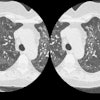AJR Am J Roentgenol 1996 Jul;167(1):105-109
Diagnostic accuracy and safety of CT-guided percutaneous needle aspiration biopsy of the lung: comparison of small and large pulmonary nodules.
Li H, Boiselle PM, Shepard JO, Trotman-Dickenson B, McLoud TC
Department of Radiology, Massachusetts General Hospital, Boston 02114, USA.
OBJECTIVE. The purpose of this study was to compare the diagnostic accuracy and safety of CT-guided percutaneous needle aspiration biopsy of pulmonary nodules less than or equal to 1.5 cm in diameter with those of nodules greater than 1.5 cm in diameter. MATERIALS AND METHODS. We retrospectively reviewed a consecutive series of 97 patients who underwent CT-guided percutaneous needle aspiration biopsy of a lung nodule and then surgical resection (n = 95) or autopsy (n = 2). By examining CT images, we classified 27 nodules as small ( < or = 1.5 cm) and 70 nodules as large ( > 1.5 cm). Diagnostic accuracy was calculated by comparing cytologic diagnoses based on biopsy with final diagnoses based on histologic findings from surgery or autopsy. Each case was reviewed for possible complications, including pneumothorax and chest tube placement.
RESULTS. The diagnostic accuracy of CT-guided percutaneous needle aspiration biopsy of large nodules was 96%. The diagnostic accuracy for small nodules was 74%, a statistically significant difference (p < .05). The prevalences of pneumothorax in our population were nearly identical for small and large nodules (22 and 21%, respectively). The prevalence of chest tube placement in our population was approximately 2%. The prevalences of chest tube placement were 0% for small nodules and 3% for large nodules.
CONCLUSION. CT-guided percutaneous needle aspiration biopsy is significantly less accurate for small pulmonary nodules than for large pulmonary nodules, but the complication rates for both are low.
PMID: 8659351, MUID: 96258676







